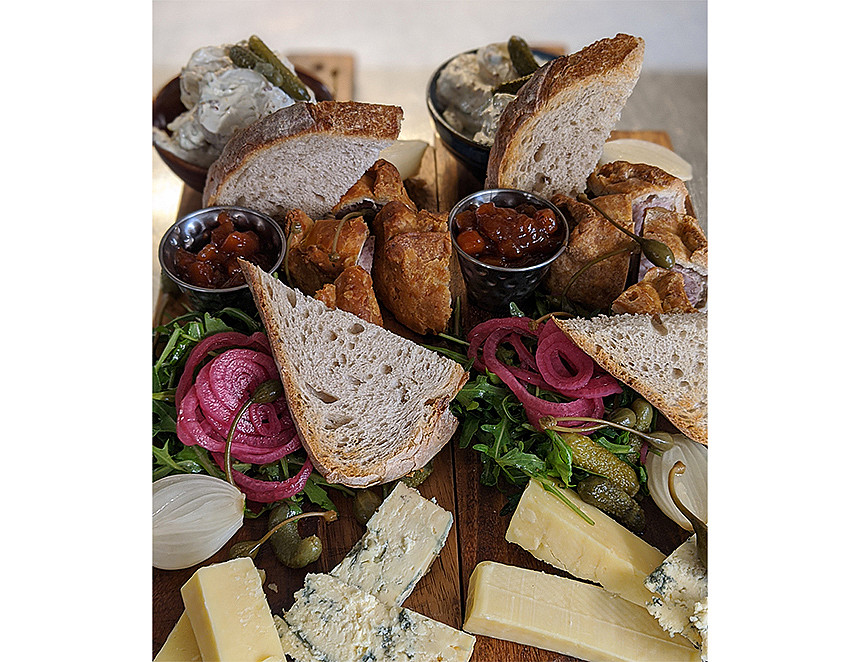Best bitter ploughman’s
Audio Description
Login here to listen to the audio description

I am writing this as the UK basks in another heatwave, while a good few of you may have been sat sipping a refreshing pint or two in a bucolic country pub garden. You know where I mean. As you enter you can hear the smack of leather on willow from the nearby village green, the echo of your footsteps on the cool flagstone floors and the friendly welcome from the bar staff. Above the bar is a chalkboard menu of delicious food. And if I asked you what would be on that menu, I bet most of you would say a ploughman’s.
The image of the ploughman’s lunch dates to the 18th century when farm labourers dug out cheese and bread from their leather satchels, eating in the field at 10 in the morning and six in the evening working from sunrise to sunset. In 1891 the Dundee Courier recorded a court case where a group of ploughmen took their employer to court to restore their right to bread and cheese which had been taken away. So, when you sit down to a plate of Cheddar, Stilton, crusty bread and pickles you are part of a longstanding agricultural tradition.
Almost. The ploughman’s lunch as you and I know it, all apples, celery, pickled onions, and chutney is really a modern-day creation. It gained popularity as the result of a crafty marketing campaign following the relaxation of rationing by the Milk Marketing Board to encourage people to eat cheese. Pubs made the ploughman’s because it required little or no cooking and was quick and easy to prepare. Now, that doesn’t mean I’m not a fan and the key for me is the chutney - the culinary glue that holds the whole dish together. And there is no better chutney than my Sussex Best Bitter chutney.
You can use your favourite best bitter, but my choice is Harvey’s Sussex Best (4 per cent ABV). Brewed in Lewes at the family-owned firm, Sussex Best starts with water from the Victorian-designed brewery’s own artesian well. Maris Otter and Crystal malts and four local varieties of hop create a balanced, easy-drinking ale that has won the Best Bitter category in CAMRA's Champion Beer of Britain competition twice (2005 and 2006). Crack open a chilled bottle, grab a wedge of your favourite cheese, maybe a slice of thick-cut ham or a jelly filled pork pie, some freshly baked, crusty bread and my chutney and enjoy your own fabulous ploughman’s.
Best bitter chutney (makes two jars)
2 large onions, peeled and finely chopped
2 large carrots, peeled and diced
4 large celery sticks, washed and diced
2 large cooking apples, peeled, deseeded and chopped
50g dried dates, roughly chopped
50g dried apricots, chopped
50g raisins
4 cloves garlic, peeled and crushed
150g dark brown Muscovado sugar
250ml Sussex Best Bitter
100ml malt vinegar
2tbs wholegrain mustard
1tbs tomato puree
half tsp ground cinnamon
half tsp ground coriander
Generous pinch cayenne pepper
Place the dried fruit in a bowl and add the beer, cover with cling film and leave in the refrigerator overnight.
Pour the vinegar and sugar into a large, heavy-bottomed pan and bring to the boil, stirring until the sugar dissolves. Add the vegetables, garlic and spices then simmer gently for 20 minutes.
Add the dried fruits, beer marinade, tomato puree and mustard and simmer for around an hour or until the mixture is thick and shiny. Stir regularly to prevent the chutney sticking and burning.
Remove from the heat and allow to cool slightly then transfer to clean, sterilised jars. You can do this by placing the clean jar and lids in a large pan. Cover with water and bring to a rolling boil for 10 minutes. Allow to cool and drain before use. The chutney is best made in advance and improves with time.

 view archive
view archive
 view events
view events